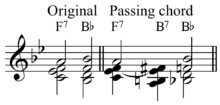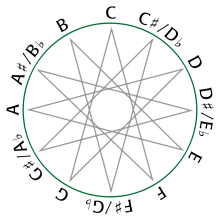- Passing chord
-
 Passing chord in B♭ from across the circle of fifths (tritone, see also tritone substitution): B♮7
Passing chord in B♭ from across the circle of fifths (tritone, see also tritone substitution): B♮7
 Play (help·info)[1].
Play (help·info)[1].In music, a passing chord is, "a nondiatonic chord that connects, or passes between, the notes of two diatonic chords."[3] "Any chord that moves between one diatonic chord and another one nearby may be loosely termed a passing chord. A diatonic passing chord may be inserted into a pre-existing progression that moves by a third in order to create more movement."[4] "'Inbetween chords' that help you get from one chord to another are called passing chords."[5]
For example in the chord progression[4]:
|Cmaj7 |Em7 |Dm7 |G7 |
the diatonic passing chord (Dm7) may be inserted:
|Cmaj7 Dm7 |Em7 |Dm7 |G7 |
or the chromatic passing chord (Ebm7) may be inserted:
|Cmaj7 |Em7 Ebm7 |Dm7 |G7 |
A chromatic passing chord is, "a chord that is not in the harmonized scale"[6].
Passing chords may be consonant or dissonant[7] and may include flat fifth substitution, scalewise substitution, dominant minor substitution, approach chords, and bass-line-directed substitution[5].
See also
- Nonchord tone
- Turnaround (music)
- Blues turnaround
Sources
- ^ Shanaphy and Knowlton (1990). The Do It Yourself Handbook for Keyboard Playing, p.68. ISBN 0943748003.
- ^ McCartin, Brian J. (1998). "Prelude to Musical Geometry", p. 364. The College Mathematics Journal 29, no. 5 (November): 354–70. (abstract) (JSTOR).
- ^ Wyatt and Schroeder (2002). Hal Leonard Pocket Music Theory: A Comprehensive and Convenient Source for All Musicians, p.144. ISBN 063404771X.
- ^ a b Rawlins and Bahha (2005). Jazzology: The Encyclopedia of Jazz Theory for All Musicians, p.104. ISBN 0634086782.
- ^ a b Sokolow, Fred (2002). Jazzing It Up, p.9. ISBN 0793591120.
- ^ Berle, Arnie (1995). Understanding Chord Progressions for Guitar: Compact Music Guides Series, p.34. ISBN 0825614880.
- ^ Alfred White, William (1911). Harmony and Ear-Training, p.158. Silver, Burdett & Company.
Chords By type - Ninth
- Eleventh
- Thirteenth
- Upper structure
Added
/ omitted- Sixth
- Minor sixth
- Augmented sixth
- Power chord
- Lydian chord
- Seven six chord
By function Secondary- Secondary dominant
- Secondary leading-tone
- Secondary supertonic
With names - Elektra chord
- Farben chord
- Hendrix chord
- Mu chord
- Mystic chord
- Northern lights chord
- Petrushka chord
- Power chord
- Psalms chord
- So What chord
- Spider chord
- Tristan chord
- Viennese trichord
- Dream chord
Other - Common chord (music)
- Mixed interval
- Open chord
- Polychord
- Primary triad
- Quartal and quintal
- Slash chord
- Subsidiary chord
- Synthetic chord
- Tone cluster

This music theory article is a stub. You can help Wikipedia by expanding it.

